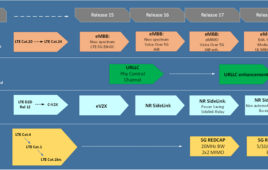Fixed-mobile convergence (FMC) has plenty of good applications although its future relies on other technologies and larger industry factors.
How will the model of fixed-mobile convergence (FMC) play out in the next few years? From carriers to consultants, the consensus is that FMC will definitely happen, but its development, mainstream acceptance and eventual ubiquity will occur more as a side effect of industry trends than as a specific agenda.
Technologies such as all-IP network infrastructures, unified communications and wireless broadband will be some of the major enablers in FMC’s future.
 |
| Thomas: FMC is the latest flavor of convergence. |
“I don’t think the term FMC is very meaningful. It’s a stop-gap kind of thing,” said Forrester Research analyst Brownlee Thomas. “Is it going to be fixed-mobile substitution so I don’t really need a landline? That’s not really FMC. At the technology level, it’s still way out there. From a consumer perspective, and also from an enterprise perspective, we don’t really care about the underlying technologies. We just want it to do what it can do at a good price.”
FMC has been slow to catch on, but that has been out of its advocates’ control. “The reason it didn’t catch on is because we had these key systems and these PBXs that worked fine… and they had a shelf life of 25 years,” Thomas said.
“Fixed-mobile is just the newest iteration of convergence. The impact of 4G networks, unlicensed mobile access and VoIP all becoming mainstream will cause erosion and evolution of the barriers between separate networks,” she said.
Enterprise technology buyers may care for now that what they’re installing is called FMC by suppliers, but for consumers FMC is all about service bundles. According to Thomas, all voice and data services will be flat-rate and the bundles will be targeted for different uses and lifestyles such as business travelers, families and college students.
The change is already under way. Kim Ganote, director of product development at Sprint Nextel, said her company’s plans for an enterprise FMC portfolio began almost five years ago. Now the catalog includes find-me/follow-me, PBX extension for BlackBerry devices, broadband wireless networking and custom services.
“Our IMS network architecture and the whole design of that really was to allow any type of network, any type of device, and allow for seamless integration. We really look at it as, you’ve got a lot of customers and businesses that are mobile [and] you kind of have that whole blend in the middle. That is partially mobile, partially in the office, might be traveling for their positions or are seasonal,” Ganote said.
There are industry-wide advancements happening beyond just converging the backend services such as billing and IP backbones, according to Ganote.
“I certainly think we have a pretty robust portfolio right now, but we’re still in the early stages also. We’ll certainly continue to look at FMC. I think how it works with unified communications is the next big thing to tackle and understand. There are a lot of things that we’re still researching and investing in there,” she said.
Today’s focus on unified communications is expanded to include collaboration, instant messaging and location/presence management. Such applications are difficult to design because customer preferences in communication styles can sometimes change faster than companies can keep up — so the R&D can be tedious and it’s challenging to integrate the latest software with legacy equipment and myriad customer configurations. To help, Sprint tries to stick with IMS standards in the integrates process. applications. Ganote said that many of today’s integrations still need enhancement, which is a concern because if they are not done properly they can actually end up costing more and being less efficient than whatever the customer had before.
Another way to integrate today’s applications is to partner with more software companies and to share applications across networks. Sprint already has started the former; for example, it recently announced plans to license the Voice Mobility Suite from Research In Motion subsidiary Ascendent Systems. That deal, announced at the CTIA Wireless show in April, gives companies a software-only approach to extending PBX systems to employees’ mobile phones. Verizon Wireless offers the same package.
Sprint is looking ahead and working out details of application-sharing opportunities. Although there are no specific details available, Ganote said an example could be an extranet in which enterprises extend corporate applications databases, e-mail and technical support to customers and partners even if they use different operators.
“FMC was pushed quite a bit by the wireline industry, and it’s trying to tap into the wireless industry,” noted Miguel Myhrer, a partner in Accenture’s Global Wireless Network division. However, “The wireless players see themselves with a potential advantage. It’s just a natural evolution of their technology,” he said.
Myhrer said adaptable and distributed antenna systems, along with femtocells and picocells, are all positive developments that may become the building blocks of the silent FMC revolution. Handset strategies also could help if, for example, more carriers were to proactively embrace Wi-Fi rather than take a wait-and-see direction. Also, “One of the things that I see coming up is the deployment of flat IP networks in the 4G arena,” he said. “Once those networks are deployed, at that time, there’s greater reason to start converging the wireline networks and the wireless networks because you can do convergence in the backend as well.”
Like Forrester’s Thomas, Myhrer said he believes the FMC hype until recently was ahead of technology, and that the term itself will be increasingly irrelevant in a few years from now. Wireless carriers are starting to understand why wireline carriers view FMC as valuable – for many years wireless providers either didn’t have or didn’t understand the incentive to partner with traditional phone companies, he said. But now, the wireless industry focus is much more about near-term challenges such as reducing costs and increasing network capacity. More research is needed for common tasks like moving a customer’s ringtones across dual networks, and new relationships are needed between wireline companies and infrastructure providers such as Akamai, which was an early pioneer in content delivery networks, he said.
Wireless carriers today have most of the industry clout, Myhrer added. So FMC may continue to be important, and may someday be very common, but it probably will never be a sexy commodity.




